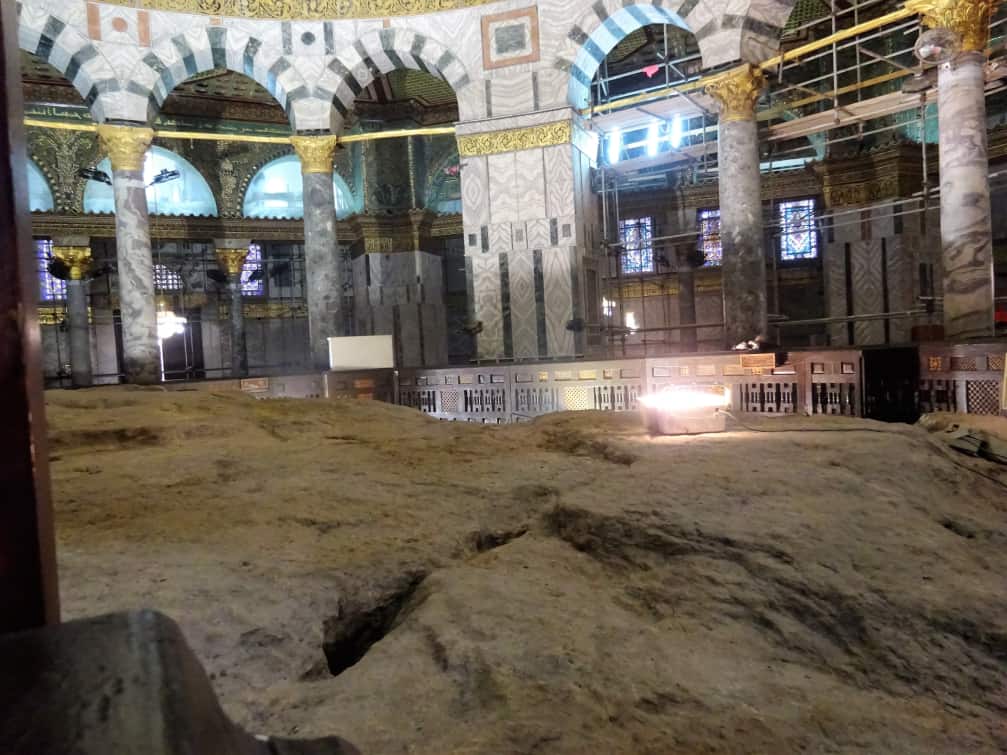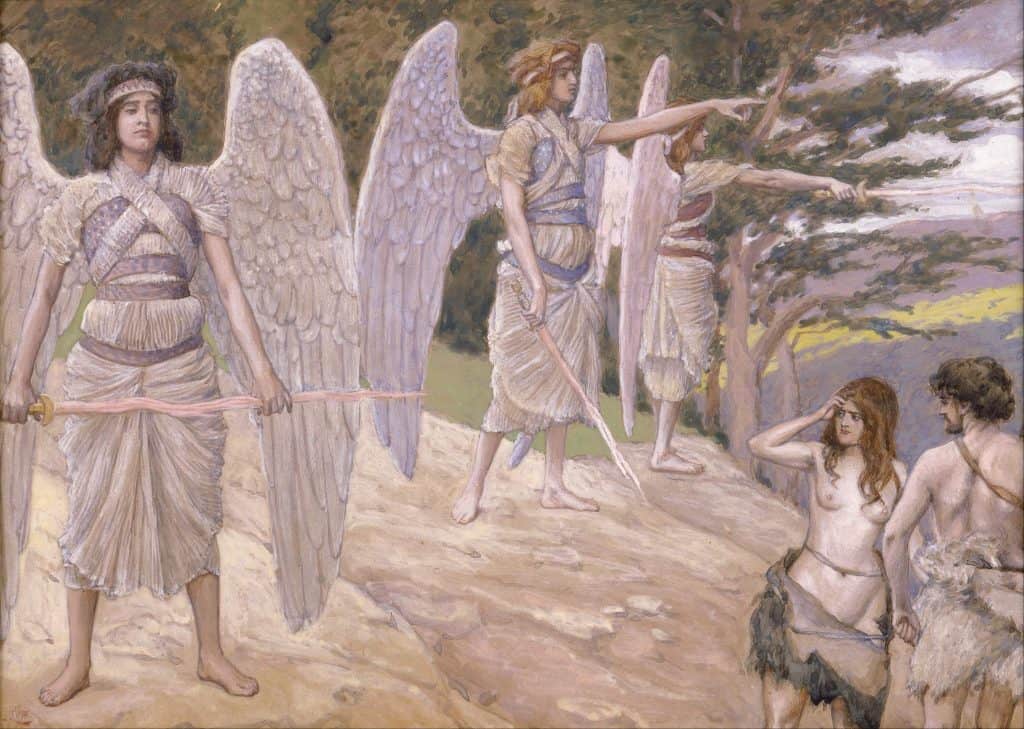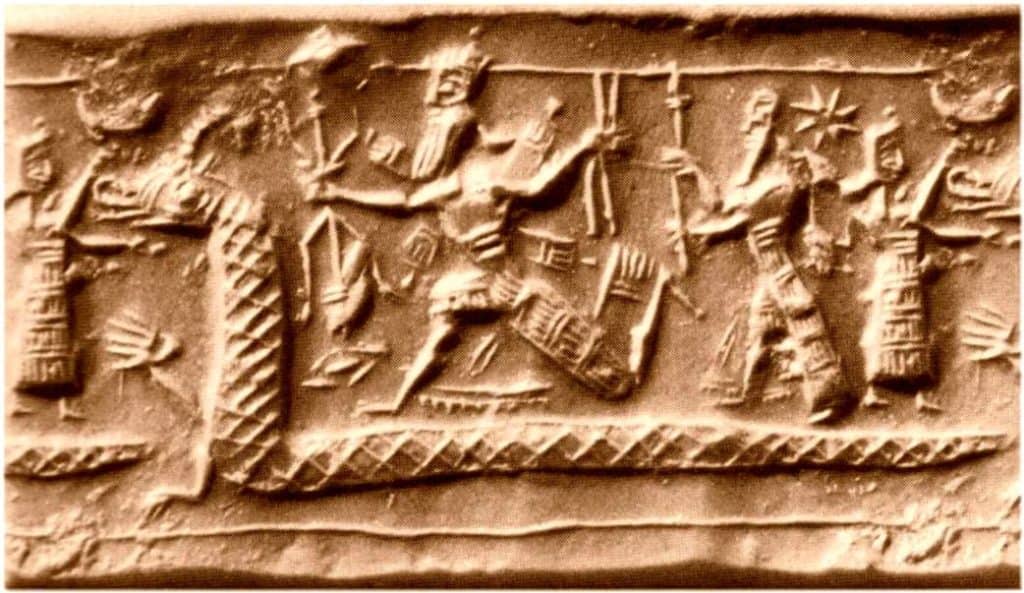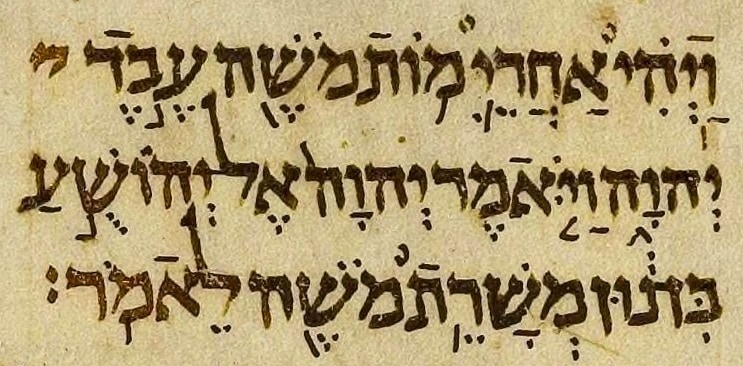The Genesis Creation Narratives that open the Book of Genesis are a Jewish cosmogony, which tries to explain our origins. The first three chapters are a part of the genre of creation myths. These chapters come in close contact with other Mesopotamian and Near Eastern creation myths.

(Credit: Eigenes Werk CC-BY-SA 4.0)
The first creation story is extraordinary for its austerity. Other ancient Near Eastern evocations of God’s, or the gods, world ordering activity, including many in the bible itself, provide high drama and graphic description of the events.
Genesis, however, is utterly devoid of sensory detail. This eerie abstractness combined with the highly schematic and formulaic structure of the narrative conveys a sense of the awe-inspiring majesty and inviolable sovereignty of the god on whom the narrative is unswervingly focused.

More About Genesis Creation Narratives
The correlation between things created on the various days exhibits a high degree of symmetry: The first three days describe the creation of generalities or domains: And the next three chronicle the creation of the specifics or the inhabitants of the domains in the same order.
In the first creation story, creation comes to its culmination, however, in that one day, that has no counterpart – the sabbath – here observed by god above and not yet enjoined upon by his people Israel.
Critical scholars tend to attribute the first creation story to the P source. At the same time, the second creation story is attributed to the J source. The documentary hypothesis states that in the Pentateuch (the first five books of the bible) we find parallel stories, like the creation stories that sometimes conflict in their details. Also, we can find different styles and ideas in each source. This lead to the conclusion they were written down at different periods in time and by other authors and then edited later into one book.
The J source is considered the earliest that goes back to the 9th century BCE originating from the Kingdom of Judea. During the Priestly source, hence the letter P, scholars date to the 6th century BCE in Babylonia.
The Genesis Creation Narratives And Cross-Cultural Compassion
In the first creation story, God does function here in ways reminiscent of a Kohen (Priest in Hebrew). He gives blessings and consecrates the sabbath. The concern shown here for order, and clear boundaries typify the priestly corpus.
If we make a bit of cross-cultural comparison, we will find that Genesis chapter 1 likely responds to the Babylonian creation myth called the Enuma Elish. For example, The Biblical narrative starts with the words “when in the beginning” while the Enuma Elish begins with the words: “When on high.”
Moreover, the Hebrew cosmogony ends with god resting on the 7th day, hallowed on the 7th day, therefore we have a day of rest. The Hebrew creation story makes time sacred.
The Enuma Elish begins: “when on high” there is a specific place and ends with the founding of the Babylonian capital – space. What does it mean? Genesis 1 was probably written while in exile in Babylon by Jews.
The Enuma Elish is the myth of the conquering kingdom – so what the authors of Genesis 1 are trying to say is we have our own god our own story and we will privilege time rather than space. Because that is what makes sense when you are in exile away from your temple, apart from your land.
The Enuma Elish – A Babylonian Creation Myth
In the Enuma Elish, we encounter two gods of water: one, a male god with the name of Apsu – the god of freshwater. And the more important god – Tiamat – is actually a goddess – is the goddess of saltwater and they represent primeval chaos.
We have that same primeval chaos in genesis chapter one where the spirit of god hovers the water deep. In the Enuma Elish the younger generation of gods, headed by the god Marduk, goes to war against Tiamat, which is the most recalcitrant.
Eventually, he gets the aid of the seven gods of wind and basically blows Tiamat up. He splits her body open and with part of her body he makes a vault, this is the bible’s firmament, and with the bottom part of her body, he makes the earth.
Genesis Creation Narratives: The Spirit of God Hovers Over the Face of the Deep
In Genesis, the spirit of God hovers over the face of the deep. But the word spirit in Hebrew also means wind. So here we have the 7 wind gods in the Enuma Elish and the wind of god hovering over the face of the deep. And what does God do? God decides to separate the water above from the water below. Makes organization out of chaos, and creates a vault of heaven and a vault of the earth. It’s the same story! But here, there is no war between the gods. Here there is one singular God, not manipulating matter but creating by the word of his mouth.
In the Enuma Elish Marduk decides to create humanity out of the blood of a dead god. And humanity is meant to be slaves to Marduk and all of his bodies. In the biblical creation story it is said: “let us make man in our image”.
We are not meant to be slaves to the gods but in God’s image. And we are given dominion over the birds, fish, and the entire world.
“To be fruitful and multiply and subdue it”
Genesis 1

(Credit: Ben Pirard)
The Differences Between The Two Accounts
In Genesis 1 the world is good, man and women are equal. Unfortunately in genesis 2 things are starting to go downhill. Chapter 2 is another creation story but a much a different one. Instead of being everywhere with the creation of the world, we’re now in the garden, a very particular place. And instead of having an abstract god names ‘Eloim’ who speaks from the heavens, we now have a different god called YAWH who walk in the garden of Eden and fashioned humankind from the mud. This is a very different story.
Problems of Dating
In terms of dating, the common view is that genesis chapter 2 is actually an earlier story than Genesis 1. Gen chapter 1 as I mentioned earlier was written in the 6th century BCE when the Jews were in exile in Babylon. Gen 2 is dated much earlier, perhaps 900 before the common era, which is a non-confessional term to BC (before Christ). Perhaps it was written down in the time of King David or after him, we can read gen 2 as a completely flowing narrative, gen chapter 1 into gen chapter 2 into gen chapter 3 or you might see chapters 2 and 3 as a separate unit with its literary integrity and theological concerns.
In Genesis chapter 1, God creates out of nothing – ex nihilio – he says let’s create humankind and what happens. But in Chapter 2 it’s pretty different, the first human to be made is called a man but an earthling could be more exact.
In most translations, we find genesis chapter 2 verse 7 reading quote: “then the lord god formed man from the dust of the earth… “
As wind with the term ‘wind’ which means spirit and wind in Hebrew the word for man is Adam in Hebrew while the word ground means ‘Adama’. The English masks a wonderful pun. God created adam from the Adama or earthling from the earth. The same land that will be cursed to man. But for now, the creation story is trying to tell us is we have an intimate connection with the earth. We are part of this created world.

The Differences Between the Two Creation Stories
Moreover, there is a theological point here as well. The god of Genesis 1 is transcendent, above, speaking from afar. The god of chapter 2, this YAWH god called lord, is like a potter who forms humankind from clay and molds it. This is an immanent God, he is here in the world, and he walks around the Garden of Eden in the cool of the day. In short, a much different view of God, earlier not in exile for a different community. And here, God has a different plan for humanity. According to Genesis 1, God tells man and women to fill the earth, subdue it, be fruitful, and multiply. That is not what this earth creature, this earthling, gets in Genesis chapter 2, instead, the earthling is commanded: “go into the garden of Eden and till it and keep it”.
The ancient Israelites, perhaps in the year 900 BCE or so, were often subsistence farmers that were trying to get that rocky hill country soil to produce something – the garden of Eden is their paradise. Eden is what they wished for. Perhaps the Garden of Eden for these ancient Israelites is a romantic notion of those good old agricultural days before there was urban planning and before there was a monarchy.
To be a farmer in Israel is very difficult. Gen 2 gives us a romantic gloss over something very, very hard.
Genesis Creation Narratives: More Differences
Now in terms of injunctions and commandments. In the 1st chapter of Genesis, there is only that positive command to be fruitful and multiply. In the 2nd chapter of Gen, there is negative command, and it’s particularly problematic because it has no explanation. The lord informs the human:
“you may eat from any tree in the garden but from the tree of knowledge, of the good and evil, you shall not eat, for the day you eat of it, you will surely die”
Genesis 2
Next thing we find out, why is this there? What are the theological questions? We often think of the temptation as Eve coming up to Adam trying to tempt him, but is that tree god planted the first temptation? Is that what God is doing? Or does God already know what will happen? Is the succumbing of humanity to the temptation preplanned?
Genesis Creation Narratives: Was Humanity Created Mortal or Immortal?
We might even ask ourselves whether humanity was created originally mortal or immortal. Because we also discover that not only is there a tree of knowledge of good and evil in the center of the garden, but there is also a tree of immortality. Why plant a tree of immortality if people are immortal, to begin with?
But why trees? Is it because the ancient world believed that agriculture was their anchor? The tress gave fruit somehow miraculously. Somehow the tree was the connection between the earth and the heavens where branches grew.
The tree is a cross-cultural symbol, and the specific ways each culture uses that symbol permit an understanding of that culture’s values.
In the second creation story, men and women are not created simultaneously. Here we have the creation of man, and then all the animals, and then women. We might view these as two separate stories, but we can also read these texts as connected.
Genesis Creation Narratives: First Act of Disobedience
We know from Genesis ch 2 that the Lord had forbidden the man from eating from the tree. The women who would not be called eve until the end of the chapter know this interdiction. It’s not, however, clear who told her, she hadn’t been created yet. She does know the story, and here we have it with the conversation with the snake:
Now, the snake is one of god’s creatures, and I remind you when god created all living creatures it was “all good.” His question is tricky, and he doesn’t admit to a yes-or-no answer. The woman, who had never heard the commandment, paraphrases it closely. Yet it is unclear why she adds the prohibition on touching the fruit.
In verses 4-5, the serpent impugns God’s motives, attributing the command to jealousy. Whereas in the first creation account, human beings are God-like creatures exercising dominion (1. 26-28), their ambition to be like God or like divine beings is the root of their expulsion from Eden. The fatal progression in the woman’s mind begins with the physical (eating), moves to the aesthetic (a delight to the eyes), and culminates in the intellectual (a source of wisdom). The progression may reflect the process of rationalization to which she succumbed just before she engaged in humanity’s first act of disobedience.







